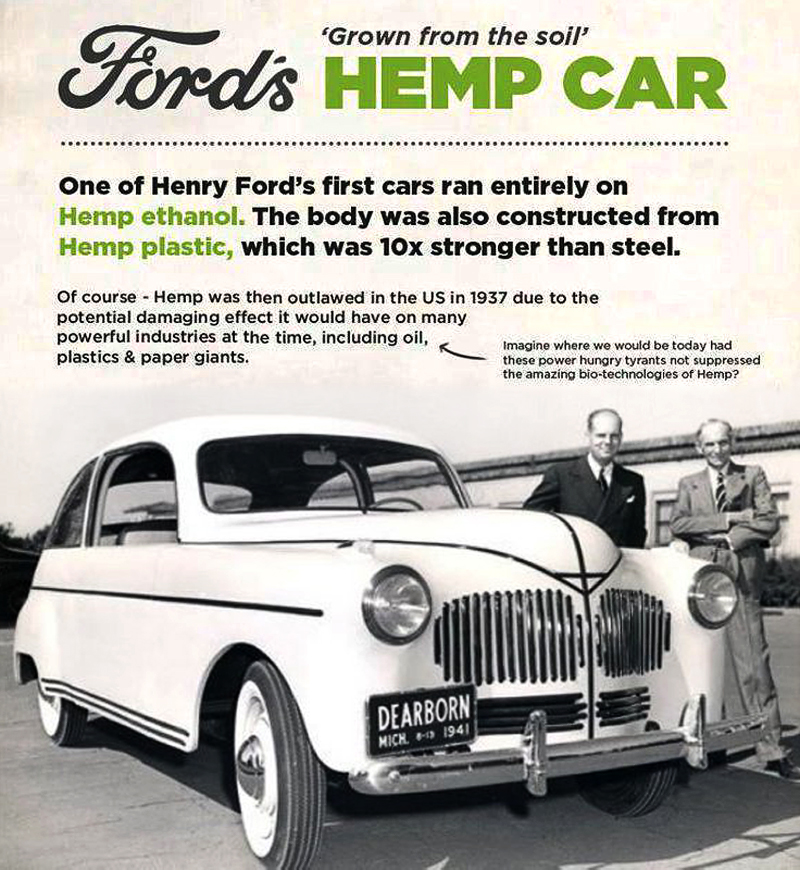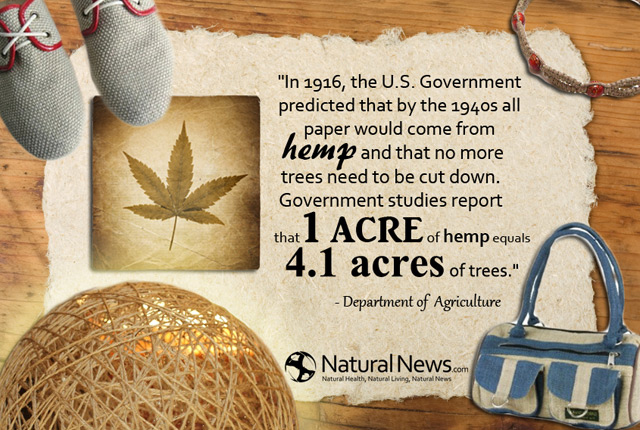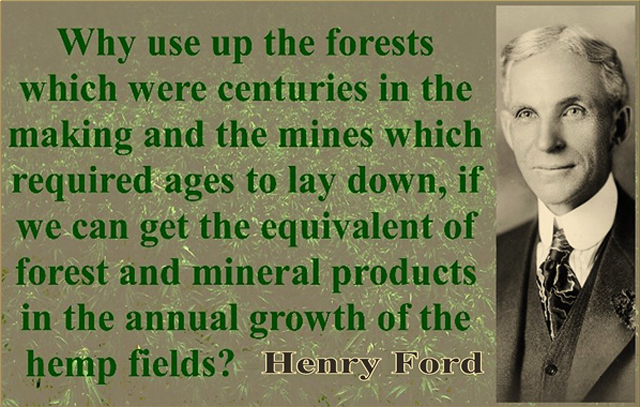ShopDreamUp AI ArtDreamUp
Deviation Actions
We might think that our ethanol and biodiesel “flex-fuel” systems are all very cutting edge, but biofuel development is of course nothing new. Way back in the 1930's, Henry Ford was hard at work in the alt-fuels sector, and in 1941 he constructed a hemp-fueled and hemp-bodied prototype car. The 'plastic' body panels were composed of 70% cellulose fibers, including industrial hemp, mixed with a resin binder, and apparently they were pretty sturdy.
The reason marijuana was prohibited in the 20th century was to suppress hemp fuel and fiber production, which is inexpensive to make and naturally decentralized, so that small groups of people could profit from the capital intensive petrochemical alternatives that dominate our political process and economy today.
Hemp will decentralize our economic system and return wealth and control to the majority.
Hemp & marijuana both come from the same plant, Cannabis sativa, which is the Latin, botanical name.
Hemp is the fiber from the stalks and stems and the sterile seeds, while marijuana is the leaves, flowers and viable seeds. Some people believe that hemp with a low THC content is one species, and that it becomes a different plant, marijuana, when the THC level in the cannabis plant goes above 0.3 percent, but it is really the same plant. It is really about fuel, fiber and the synthetic subversion of the natural cycle. Drugs are only a smokescreen. Marijuana prohibition has always been about money, power, and control.
Source: In5d
The Corporate Conspiracy that Killed Industrial Hemp
Hemp cultivation is big business. Even though it hasn't been grown in the United States for decades, America is one of the fastest-growing hemp markets. In 2011, the U.S. imported $11.5 million worth of legal hemp products (mainly from China), up from $1.4 million in 2000. With the recent anti-smoking movement and declining tobacco exports, hemp is high on the list replacement crops for tobacco farmers.
Industrial hemp is one of the most versatile plants known to man. Hemp fiber is used in the production of paper, textiles, rope, sails, clothing, plastics, insulation, dry wall, fiber board and other construction materials; while hempseed oil is used as a lubricant and base for paints and varnishes, as well as in cooking and beauty products.
Hemp first began losing ground in 1850 to cheaper substitutes made of cotton, jute and sisal. Prior to 1917, hemp had to be processed by hand, involving huge labor costs incompatible with mass commercial production. After George W Schlicten automated hemp processing in 1917 with a new machine called the hemp decorticator, Henry Ford set up the first biomass fuel production plant in Iron Mountain Michigan. His intention was to run his Model T on hemp-based ethanol.
All this was happening at the precise moment that the munitions company DuPont was patenting synthetic fibers (nylon, rayon, Dacron, etc) and plastics derived from petroleum. Hemp posed a major threat to DuPont’s ability to market these synthetic fibers for fabrics, rope and other products because hemp was so cheap and readily available. The chemical giant also had a commercial interest in replacing hemp-based paper with paper produced from wood chips (they held the patent on the sulfates and sulfites used to produce paper pulp) and in replacing ethanol with gasoline as the major fuel source in automobiles (they held the patent on tetraethyl lead, which allowed gasoline to burn more smoothly in the internal combustion engine Ford designed to run on ethanol).
The main co-conspirators in the plot to kill hemp included DuPont, William Randolph Hearst (who owned a logging company and a paper manufacturing plant) and Andrew Mellon, president of Mellon Bank and DuPont’s major financier.
In 1930, Mellon, as US Secretary of the Treasury, created the Federal Bureau of Narcotics and appointed his nephew Henry Anslinger to run it. Between 1935 and 1937, Anslinger and a handful of DuPont’s cronies in Congress secretly wrote a bill to tax hemp production.
Meanwhile Anslinger and Hearst orchestrated a massive media campaign demonizing a dangerous new drug called Marihuana that supposedly turned Mexicans and black jazz musicians into crazed killers. Anslinger and his cronies rushed through the Marihuana Tax Act of 1937 on a Friday afternoon before any lawmakers had a chance to read it. Only a handful realized the crippling effect the new law, which would also tax hemp, would have on the hemp industry.
In 1970 the 1937 Marihuana Tax Act was declared unconstitutional and replaced with the Controlled Substances Act. The latter official equated hemp with the drug marijuana (even though they come from very different plants) and enacted an official prohibition against hemp cultivation.
Full article at Veterans Today
NyghtVision 13-2
I'm happy to announce that the latest edition of NyghtVision Magazine has now been published. Take a look here if you like :dance:
Website | Print Shop | Blog
NUCLEAR NOW by Oliver Stone (official trailer)
NUCLEAR NOW takes viewers on a mind-opening journey with legendary director Oliver Stone as he reveals the true history of nuclear energy and its potential to solve climate change. The looming climate crisis remains unresolved, and the volume of carbon-free electricity needed over the next 30 years is almost unimaginable. This film aims to remove the fears associated with nuclear energy and highlight the sustainability and affordability it can bring in the pursuit of restoring the world’s ecosystems and economies.
Website | Print Shop | Blog
NyghtVision 13-1
I'm thrilled to announce that some of my flower photos have been included in the latest edition of NyghtVision Magazine. Take a look here if you like :dance:
Website | Print Shop | Blog
Ladies and Gentlemen! The President of Ukraine!
Website | Print Shop | Blog
Featured in Groups
© 2015 - 2024 KeldBach
Comments0
Join the community to add your comment. Already a deviant? Log In


